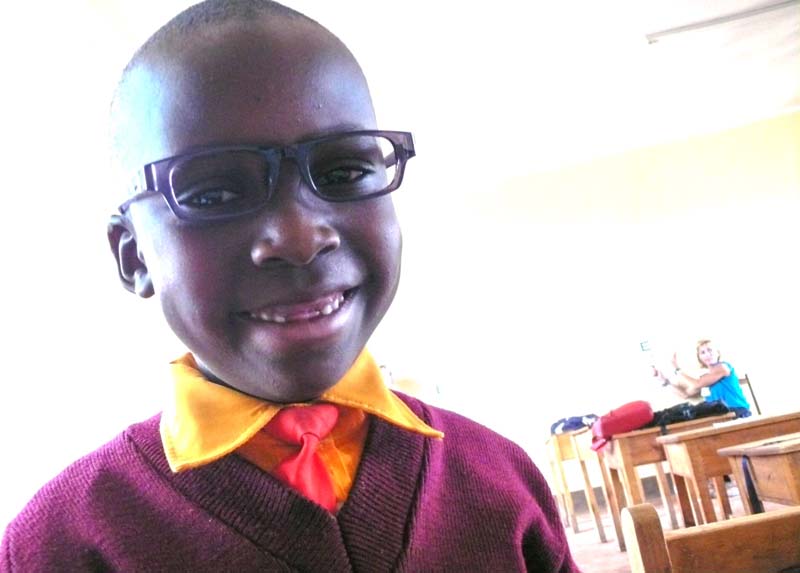The Silent Crisis: How Malnourishment and Ignorance Are Increasing Eye Problems in Africa

For millions of people in underdeveloped regions across Africa, losing their vision is not a distant possibility—it’s a daily reality. Not because of an incurable disease, but due to something entirely preventable—malnourishment and lack of awareness.
Children struggling to read the blackboard. Mothers unable to thread a needle. Farmers who can no longer see their crops. Millions are living in a world that is slowly fading into darkness—simply because they lack the nutrition and resources needed for healthy eyesight.
At First Sight, we refuse to accept this reality. We believe clear vision is a right, not a privilege. By addressing the root causes of preventable blindness, we are helping people see, learn, and thrive.
The Hidden Link Between Malnutrition and Vision Loss
Vitamin Deficiencies: A Leading Cause of Blindness
Most people don’t realize that poor eyesight isn’t always caused by genetics or age—it can result from poor nutrition. In many African communities, access to nutrient-rich food is limited, leading to a dangerous cycle of malnourishment and vision deterioration.
According to the World Health Organization (WHO), Vitamin A deficiency alone causes 250,000 to 500,000 cases of childhood blindness every year. Half of these children die within 12 months due to weakened immune systems.
Vitamin A Deficiency (VAD): Leads to night blindness, dry eyes, and, in severe cases, complete loss of vision.
Zinc Deficiency: Prevents the body from properly absorbing Vitamin A, worsening eyesight.
Lack of Omega-3 Fatty Acids: Weakens the retina, increasing the risk of vision impairment.
Iron Deficiency: Contributes to optic nerve damage, causing blurred vision.
The heartbreaking truth? These conditions are entirely preventable—but many families don’t even know their children are at risk.
The Impact of Ignorance on Eye Health
Even when vision problems begin, many people don’t realize they need help.
1. No Awareness of Eye Care
In remote villages, most people have never seen an eye doctor. They don’t know what blurry vision means or that a simple pair of glasses could change their lives.
Children drop out of school.
Workers lose their jobs.
Elders become dependent on others.
And the worst part? They never realize it could have been prevented.
2. Stigma Against Wearing Glasses
Even when glasses are available, some refuse to wear them due to cultural beliefs.
“Glasses make your eyesight worse.” (False)
“Only the wealthy wear glasses.” (False)
“Wearing glasses means you are weak.” (False)
These dangerous myths prevent people from seeking life-changing solutions.
3. Lack of Access to Eye Care
For those who do want help, eye care is often out of reach.
No clinics nearby
No trained eye doctors
Expensive prescription glasses
Many people have to travel hundreds of miles just for an eye exam. The result? They simply live with poor vision.
How First Sight is Making a Difference
At First Sight, we are breaking the barriers of poverty and ignorance by bringing affordable, accessible vision solutions to communities in need.
1. Instant, Affordable Eyeglasses
Unlike traditional solutions that require:
Expensive equipment
Trained specialists
Weeks of waiting for glasses
Our portable, no-electricity-needed First Sight kits provide:
On-the-spot vision screening
Prescription glasses in under 10 minutes
A simple system that requires no formal training
2. Nutrition & Eye Health Awareness
We educate families on:
The importance of Vitamin A and other nutrients
Preventing blindness through proper diet
How early detection can save sight
3. Reaching the Most Remote Areas
We bring vision care to places no one else will go.
Rural villages
Conflict-affected areas
Underserved communities with no access to healthcare
Where there is no eye care, First Sight is there.
Real Lives Changed by First Sight
Amina’s Story: A Second Chance at Education
Amina, a 9-year-old girl from a remote village, was labeled as a “slow learner” because she couldn’t read the blackboard. Her teachers thought she wasn’t trying.
After a quick 10-minute vision test, we discovered she simply needed glasses. The moment she put them on, her world changed.
Today, Amina is back in school, excelling in her studies, and dreaming of becoming a doctor.
James’s Story: Regaining His Livelihood
James, a skilled craftsman, lost his job when his vision began to fail. Without proper eyesight, he couldn’t work—and his family suffered.
With a simple eye test and a pair of glasses, James was back to work within minutes.
Now, he’s not just earning a living—he’s training young apprentices in his community.
How You Can Help
This crisis isn’t inevitable—it’s solvable. And you can be part of the solution.
Donate – Just $4.75 provides a pair of eyeglasses to someone in need.
Spread Awareness – Share this blog and help educate others.
Partner With Us – Businesses, schools, and organizations can help fund entire communities’ vision needs.
Every act of kindness brings someone closer to the vision they deserve.
Conclusion
The rise of eye problems due to malnutrition and ignorance is not an unsolvable issue—it’s a preventable tragedy.
By providing eyeglasses, education, and access to proper nutrition, we can restore sight, transform lives, and create a future where no one is left in the dark.
At First Sight, we believe in a world where every child can see their future clearly and every adult can work with dignity.
Join our mission today at https://firstsight.org

